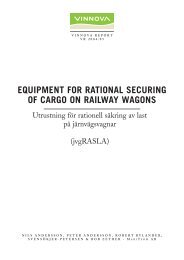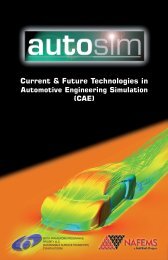WP3: Rail Passenger Transport - TOSCA Project
WP3: Rail Passenger Transport - TOSCA Project
WP3: Rail Passenger Transport - TOSCA Project
Create successful ePaper yourself
Turn your PDF publications into a flip-book with our unique Google optimized e-Paper software.
Table 2-1<br />
Reference characteristics (average new 2009 systems in operation)<br />
High-speed<br />
train unit<br />
Electric<br />
Intercity or<br />
regional<br />
Electric<br />
Intercity<br />
or<br />
regional<br />
Diesel<br />
Local<br />
city train<br />
Electric<br />
Train configuration a 2 PU + 8 Tda L + 8 T 6 DMU 12 EMUa<br />
Train length (m) 200 230 150 214<br />
Capacity (seats) ∙ load factor 510 ∙ 0.65 480 ∙ 0.40 330 ∙0.40 750 ∙ 0.35<br />
Operational mass, incl. average load (tonnes) 410 480 280 430<br />
Typical max operational speed b (km/h) 300 160 140 140<br />
Average scheduled stopping distance (km) 120 24 20 3<br />
Average speed, incl. stops (km/h) 200 105 85 55<br />
Running distance per year (1000 km) 500 250 200 120<br />
Max power at rail (kW) 9000 6000 1500 8500<br />
European rail market share (% pass-km) f 20 43 12 25<br />
Energy use – at train intake c (MJ/pass-km) 0.22 0.32 0.73 0.35<br />
Energy – from public grid (MJ/pass-km) 0.24 0.36 - 0.38<br />
GHG emissions (g CO 2 -eq per pass-km) 31 d 46 d 65 49 d<br />
of which direct emissions 0 0 54 0<br />
Sales price of train unit (MEUR) 28 16 12 14<br />
Operating costs e (EUR per pass-km) 0.063 0.101 0.127 0.095<br />
Average lifetime (years) g 25 25 25 25<br />
a<br />
DMU = Diesel multiple unit cars; EMU = Electric multiple unit cars; L = locomotive; PU = Power unit;<br />
T = trailer car; Index “a” = articulated train; Index “d” = double decker.<br />
b Maximum speed is not reached on all sections of the line and not on all lines.<br />
c<br />
Net electricity as intake to the train, i.e. energy recovery is subtracted. Intake to the railway facility into<br />
converter or transformer station) is assumed to be 10 % higher on average.<br />
For liquid fuels: energy content as delivered into the fuel tank.<br />
d Average EU-27 electricity mix (2009): 460 g CO2 -eq per kWh or 128 g per MJ, at intake to consumer.<br />
e Excl. energy, i.e. train capital + maintenance + crew + track & station & dispatch charges + train formation +<br />
f<br />
sales and adm.<br />
In percent of the considered part of passenger rail transport. Trams and local rural trains, as well as night hotel<br />
trains (together around 5–7 %) are excluded from consideration in this context.<br />
Comments<br />
There is a large variety of train types throughout Europe, and the reference selection is not<br />
representative for each member state of the EU. Of the selected trains the ‘Intercity or regional’<br />
loco-hauled electric train is expected to have slightly higher energy use and indirect GHG<br />
emissions than the European average, while the selected ‘High-speed train unit’ is expected to<br />
be slightly better in these aspects than the average.<br />
Average energy cost in European electric rail operations is in the order of 10 % of total cost.<br />
Deliverable D4 – <strong>WP3</strong> passenger 5
















